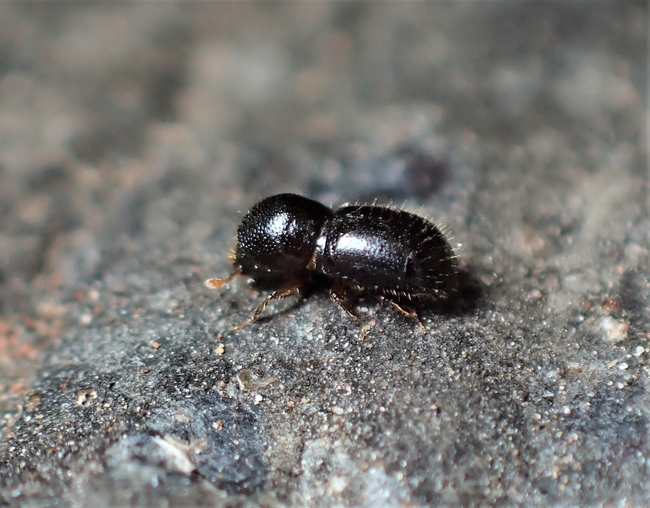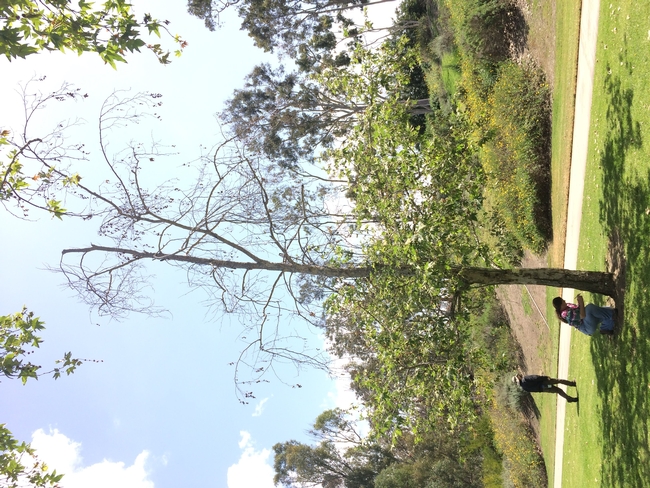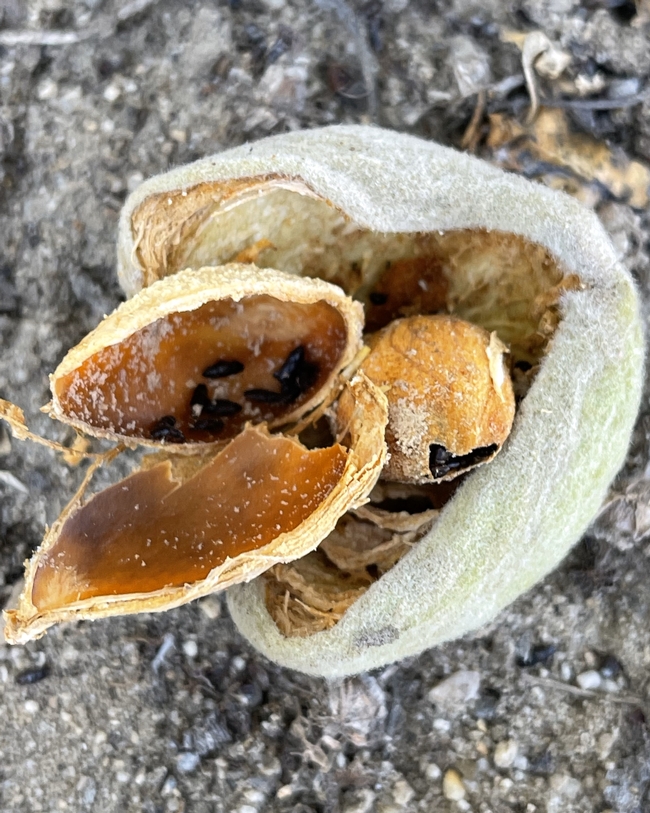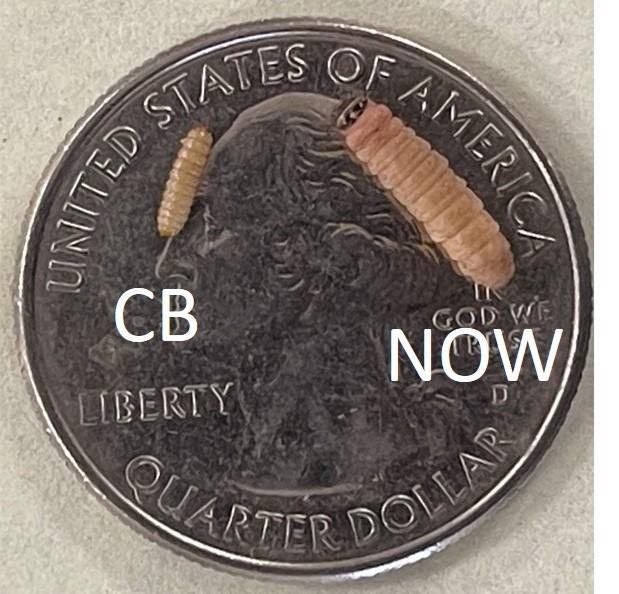Posts Tagged: IPM
UC ANR experts, resources guide response to shothole borers in Bay Area
UC Cooperative Extension scientists, partners managed invasive beetle in Southern California
Late in 2023, a potentially devastating beetle was detected in the San Francisco Bay Area for the first time. But land managers, arborists and agency staff have one big advantage as they devise plans to control the invasive shothole borers (ISHB).
Thanks to collaborations led by University of California Agriculture and Natural Resources, they can draw upon the hard-earned experience of their colleagues in Southern California. Over the past decade, SoCal communities have lost “tens of thousands” of trees due to ISHB infestations, according to Beatriz Nobua-Behrmann, UC Cooperative Extension urban forestry and natural resources advisor for Los Angeles and Orange counties.
In one regional park, about 500 trees had to be removed in the span of just one year. “That kind of impact happened in many locations; a whole street might lose 90% of the trees – all of a sudden,” said Nobua-Behrmann, a member of a statewide network studying ISHB.
Spurred by such severe impacts, UC scientists have been studying ISHB and testing various control measures since about 2012. Their lessons are now informing efforts in San Jose – where the first case in the Bay Area was detected in November 2023 – and across the region.
“The UC ANR team is comprised of subject-matter experts,” said Drew Raymond, interim agricultural commissioner for Santa Clara County. “The team has compiled all of the experience from the agencies that have been doing work in Southern California and transplanted that experience here to Northern California.”
Lucy Diekmann, UC Cooperative Extension urban agriculture/food systems advisor, and Igor Lacan, UCCE environmental horticulture and urban forestry advisor, have coordinated regular meetings and trainings of Bay Area agricultural officials, land managers and arborists.
“Lucy and Igor have been instrumental in organizing our partners to establish an effective plan for shothole borers,” said Sara Davis, city forester for San Jose. “Because experts across the broader UC ANR network have many years of firsthand experience with this invasive pest, we are able to draw on their practical know-how to guide our monitoring, management and public education efforts.”
Davis is leading a trapping program in San Jose to determine how widespread ISHB is. Aside from a recent detection in the Santa Cruz Mountains, almost all of the approximately 30 confirmed cases in Northern California have been clustered along the riparian corridor of Coyote Creek through downtown San Jose. This pattern of intense but geographically limited damage was also seen across Southern California – notably in San Diego County along the Tijuana River Valley, where ISHB wiped out the willow population.
“I would expect us in the Bay Area to see this type of localized damage that is not fundamentally different from what they're seeing in Southern California,” Lacan said.
Unusually troublesome pest triggers deadly tree disease
The invasive shothole borers – a term for two species that are virtually indistinguishable, the polyphagous shothole borer and Kuroshio shothole borer – were first detected in Los Angeles in 2003. The tiny beetles, measuring 1.5 to 2 millimeters in length, became a major concern a decade later when swaths of urban forest began dying across LA County.
Infestations are harmful – and fatal for at least 17 tree species in California – because the fungus that the beetle “farms” as its food source causes a disease called Fusarium dieback. Alarmingly, ISHB make their home in a wide variety of trees; Nobua-Behrmann said 65 tree species in California have been identified as “reproductive hosts” where they can grow their populations.
“The fact that they are such a generalist species means that they can find a host almost anywhere,” she said, noting that sycamore, box elder, cottonwoods, oaks and willows are favorites of ISHB.
Furthermore, typical tools in the integrated pest management toolbox are unavailable or ineffective for this invasive beetle. Unlike most insects, these shothole borers mate with their siblings before leaving the tree, so they don't need to search for mates afterward. This means they are not attracted to the pheromone traps typically used for pest control; traps used for ISHB only work to track their numbers, not reduce them.
“Their biology limits what we can do,” Nobua-Behrmann said. “Since the beetles spend most of their lives inside the trees, it's also hard to reach them with insecticides.”
Largely hidden within trees, ISHB can build up their numbers, undetected for years. A tree with green and plentiful leaves may in fact be harboring a significant infestation. “It's easy for this beetle go under the radar and create a big population and a big problem before you even notice,” Nobua-Behrmann said.
Monitoring and early identification of infestations are crucial
Given this pest's elusive nature, monitoring and early intervention have proven to be essential in Southern California.
“All of the success stories have a major component of monitoring and detection; if you have a good monitoring program and you can quickly identify the trees that are infested, timely action can make a big difference,” said Nobua-Behrmann, citing Disneyland in Anaheim as one example where frequent surveys and robust monitoring prevented major impacts.
As most municipalities don't have the abundant resources of a world-famous theme park, Nobua-Behrmann pioneered a program in Southern California to train community members on recognizing telltale signs of the beetle. Specifically, they looked for its entry holes, which have a characteristically round shape and size, comparable to the tip of a ballpoint pen.
Beginning with UC Master Gardeners and UC California Naturalists and then members of the general public in LA and Orange counties (and later other SoCal counties), the program trained about 100 people on how to look out for the beetle. After verification by experts, volunteers were found to be nearly 90% accurate in identifying ISHB.
Although the volunteer monitoring program is on hiatus, Nobua-Behrmann said it had clear benefits that could potentially help other regions. “It would be great to get this program going in Northern California and hopefully get volunteers and people in the general public to help identify infestations there as well,” she said.
Statewide ISHB network spreads essential information
In addition to coordinating an in-person public training in San Jose in April, Lacan and Diekmann, the UC Cooperative Extension advisors, have been educating local UC Master Gardeners on how to spot signs of the invasive beetle.
For about a decade, Lacan has been warning people about the possibility of ISHB in Northern California, routinely including shothole borers in his presentations on “tree pests to watch.” “I've been doing this since before ‘day zero,' but there was not a whole lot of interest in ISHB, as you might imagine,” Lacan recalled. “But then all of that changed in fall of last year.”
In the past year, Lacan has done a dozen ISHB presentations, workshops and webinars, attended by a total of about 260 people – predominantly city foresters, land managers, production arborists and members of tree-related nonprofits.
Lacan noted that the most effective presentations have been at in-person events featuring UC ANR-affiliated experts such as Nobua-Behrmann, UCCE environmental horticulture advisor emeritus John Kabashima, and ISHB program staff Randall Oliver and Hannah Vasilis.
“Here is where we tap into our network,” Lacan said. “This is the power of the statewide shothole borers program.”
Another vital asset has been the collection of practical resources gathered by the ISHB program, the UC Integrated Pest Management team and partner organizations. One example is a deck of identification cards depicting how symptoms of infestation differ from species to species. Such detailed information can help managers determine whether a tree is truly infested – and thus allocate their limited resources more judiciously.
“These very specific, very seriously considered materials are the kind of thing that people really appreciate,” Lacan said. “It's not just a generic ‘it's kind of like this.'”
The symptoms, broken down by tree species, are also listed on the ISHB website. Raymond, the interim agricultural commissioner for Santa Clara County, said his team uses the website to get informed about ISHB and regularly refers community members to it.
“The ISHB website has been a great resource,” Raymond said. “It's full of important and user-friendly information.”
Communities learn to protect trees, adapt to shothole borers
If community members believe a tree is infested, they should review the symptoms of ISHB-Fusarium dieback. If the signs match what they are seeing, they should take a photo of the entry hole (with the tip of a ballpoint pen placed next to the hole as reference) and send images to their county agricultural commissioner's office or local UCCE advisor, who may then seek confirmation.
Extra eyes on urban forests are crucial to help experts identify potential “amplifier trees” – heavily infested trees, with more than 150 entry holes, that are often repeatedly reinfested by subsequent generations of beetles. They contribute to the recurring pattern of severe but localized infestations seen across Southern California – and now in San Jose.
New research suggests that removing severely infested trees – or just the most impacted limbs of those trees – can significantly lower the overall ISHB population and help less-infested trees in the area recover over time.
“You're not going to eradicate ISHB (at least not in Southern California); you're not going to get rid of them – you're going to have them forever,” Nobua-Behrmann said. “But you can keep them at a manageable amount.”
She also emphasized other actions the public can take to prevent the spread of ISHB, such as correctly disposing infested plant material – ideally chipping it to less than an inch in length (or as small as possible) and then composting the chips.
“It's also important to not move firewood and instead buy it where you will be burning,” Nobua-Behrmann said. “It's one of the best things people can do to protect trees from invasive pests.”
After identifying and removing amplifier trees, land managers and landscape arborists should have a plan for replanting, Lacan added. He said they should prioritize species that are less susceptible to the beetle, using his Pest Vulnerability Matrix tool that lists the major pests for different mixes of trees.
“We need to figure out how to have sustainable urban forests, even with this pest,” he said. “We know we can do it, largely thanks to our colleagues in Southern California. So the key lesson is to replant soon – choose smartly, but replant right away.”
Celebrating the Crab Spider in Arachtober
It's Arachtober and that means celebrating arachnids for the entire month of October. Well, we ought to celebrate them year around, but October is THEIR month. Let's especially applaud crab spiders when they prey on such agricultural pests as the...

A crab spider eating a lygus bug, an agricultural pest in a Vacaville garden. (Photo by Kathy Keatley Garvey)
Visual ID guide from UC aids in managing new almond pest
Nut orchard hygiene key to control carpophilus beetle, say UCCE, UC Integrated Pest Management experts
Since the first reports of a new almond pest – the carpophilus beetle (Carpophilus truncatus) – came in during fall 2023, it has become clear that the beetle is widely dispersed across the San Joaquin Valley.
“My lab has identified infestations from every county in the San Joaquin Valley; we have found infestations in both almonds and pistachios, and we will likely find infestations in walnuts this fall,” said Houston Wilson, a University of California Cooperative Extension entomology specialist at UC Riverside. The California Department of Food and Agriculture has confirmed the beetle's presence in Stanislaus, Merced, Madera and Kings counties.
Historically a major threat to almond production in Australia, the beetle – as larvae and adults – feeds directly on the nut kernel. In California, some almond growers have lost 10 to 15% of their yield – a “significant economic loss,” according to Jhalendra Rijal, University of California integrated pest management (IPM) advisor for the region. Given the prominence of almonds as a commodity, even a 1% overall reduction statewide represents an approximately $70 million loss.
“This year there has been a lot more reports from PCAs [pest control advisers]; they're sending me the pictures of the damage and beetles,” said Rijal, noting that the increase is likely due to greater awareness of the pest.
To help almond growers identify the carpophilus beetle and develop management plans, Rijal, Wilson and their IPM colleagues have put together a visual ID guide for the beetle and the damage it causes, as well as telltale signs of navel orangeworm (Amyelois transitella) and ant damage. In particular, the experts would like PCAs and growers to differentiate between the carpophilus beetle and navel orangeworm, another key pest in almonds.
“Even though their way of causing damage looks more or less similar, we're dealing with two different types of insects,” Rijal explained. “One is a Lepidoptera moth [navel orangeworm], and the other one is a beetle – many of the management practices and biological controls would be different for these two different things.”
To control carpophilus beetle, ‘sanitize, sanitize, sanitize'
One crucial cultural practice for managing both pests, however, is destroying the remnant “mummy” nuts – the nuts that remain in the orchard postharvest. They serve as overwintering habitat for the carpophilus beetle, as well as its sustenance for the next generation of beetles in spring.
“The best way to manage this pest is to do the orchard hygiene – continuing the winter sanitation, destroying the nuts that are on the ground and on the tree and on the berms,” Rijal said.
Based on observations in Australia and locally, carpophilus beetles tend to rely more on mummies on the ground, whereas navel orangeworm generally favors mummies in the tree canopy. Correctly identifying the pest – with help from the new ID guide – enables growers to better target and prioritize their management efforts, Rijal said.
“What we are strongly emphasizing is that growers need to sanitize, sanitize, sanitize to control both pests,” Wilson added.
Correct identification of the pest would also prevent unnecessary application of insecticides, as those used for controlling Lepidoptera such as navel orangeworm would be largely ineffective on the beetle.
Indeed, another insight shared by Australian experts is that the carpophilus beetle cannot be controlled just by insecticide.
“Insecticides are not very efficient, given the cryptic nature of these beetles; exposing these beetles to the insecticide is very hard,” said Rijal, noting that the beetle spends most of its life cycle protected inside the nut.
Reporting carpophilus beetle infestation helps researchers
This harvest season, Rijal advises almond growers to harvest as efficiently as possible, to minimize the number of mummies that need to be cleaned up. And because signs of damage (like damaged hulls and frass) are most obvious during harvest time, Rijal said growers should review the new guide, using the photos and other resources to help identify potential pests.
If the grower or PCA suspects a carpophilus beetle infestation, they should contact the UCCE farm advisor in their area.
Scientists are looking to expand their knowledge about this relatively new pest to California. In the coming weeks, for example, researchers are planning to survey for the carpophilus beetle in the Sacramento Valley.
“Technically it has not been found there, but we suspect that we'll find it this fall when we go looking for it,” Wilson said.
Researchers are also collecting samples from infested orchards to better understand the biology of the species, as well as how it progresses through and responds to seasonal and climactic changes. In addition, they are analyzing data from a trial study of an insecticide that might be used as a supplemental control measure.
“This is our first full season dealing with this insect, and there are still many things we need to understand,” Rijal said. “We are continuing our research efforts on all fronts.”
Lawn-pocalypse! Surviving Drought
Ah, summer! The season of sunburns, pool parties, and… lawn droughts. If your once lush, green carpet now looks like a crunchy brown doormat, you're not alone. Let's dive into why your yard is staging a dramatic death scene and what you can do to...

Bermuda grass and weeds overtaking drought stressed turf grass.
Diagnosing herbicide problems takes detective work
Field day offers examples, tips for solving the mystery
A grower applies an herbicide to his tomato plants, or thinks a neighbor's treatment is drifting over her almond trees. A short time later, the leaves start to bleach or shrivel. Was it the herbicide? Or maybe water stress? Soil nutrients? Perhaps an insect?
Figuring out the causes of crop problems takes detective work, and like solving any mystery, it starts with knowing the signs, gathering evidence and asking questions.
The Diagnosing Herbicide Symptoms field day at UC Davis was an opportunity to see, up close, the shriveled cotton, scorched corn and dying sunflowers that can result when herbicides are applied incorrectly. Using the right herbicide – in the right proportion, at the right time and in the right field – can make the difference between a thriving crop and a financial loss.
A top take-away to avoid problems: “Don't do stuff at night!” laughed Becky Wheeler-Dykes, a UC Cooperative Extension farm advisor attending the June 26 event to better serve growers in Glenn, Tehama and Colusa counties. “The packages look the same. People grab the wrong jug.” And then, disaster.
Instructors were Brad Hanson, professor of Cooperative Extension; and Kassim Al-Khatib, the Melvin D. Androus endowed professor for weed science; both in the Department of Plant Sciences. They were joined by John Roncoroni, a Cooperative Extension emeritus farm advisor rooted in the department's weed science program. Attendees were a mixture of people from agriculture, industry, government officials, university researchers and Cooperative Extension advisors. The event was hosted by the Weed Research and Information Center, based in the Department of Plant Sciences.
Out in a field west of campus, visitors could see the progression of damage, from control plots with green and healthy crops to plants that looked sadder as herbicide concentrations increased. Visitors could see the patterns of damage for common foliar chemicals such as glyphosate, paraquat, and 2,4-D, as well as soil-applied herbicides from several chemical classes.
“There's a lot of detective work,” said Stephen Chang, a master's student in Hanson's lab aiming for a career in Cooperative Extension. “For example, the company that makes the herbicide says there shouldn't be a problem, but the grower says, there is a problem. This course helps with developing the skills to figure out what happened.”
It might not be the herbicide at all
Detective work and problem-solving frame the approach, Hanson explained. The cause of crop damage can be simple or complex. Like a good mystery, what appears to be a clue can turn out to be a red herring. Professionals need to draw on their inner Sherlock Holmes to observe and document symptoms, look for patterns in the plants and in the field, ask questions, gather information about the larger environment and collect samples.
An herbicidal Agatha Christie would then suggest: What if it's not herbicide damage at all? Participants learned to consider the possibility of insects, pathogens and viruses, as well as problems with water, nutrients, soil condition and even root damage from cultivation practices.
Hanson recalled puzzling over symptoms he found in an orchard. The culprit? “A leaking natural gas line,” he said.
More resources for herbicide issues
Participants also heard from Molly Mathews, deputy agriculture commissioner from Yolo County, on how a field investigation is conducted. Lawyer Robert Davies, of Donahue Davies LLP in Folsom, outlined the basics of what happens when there are lawsuits related to crop damage from herbicide drift.
The Diagnosing Herbicide Symptoms field day is part of a larger program of education and outreach offered through the Weed RIC, said director Julia Stover-Blackburn. It was the first time the event has been offered since the COVID-19 pandemic, she added.
- For more information about field days and resources, visit the Weed RIC webpage.
- For a thorough discussion of herbicide symptoms, visit this page overseen by Al-Khatib and sponsored by University of California Agriculture and Natural Resources.
- This online course follows an earlier version of the Diagnosing Herbicide Symptoms field program.
This story was originally published on the UC Davis Department of Plant Sciences website.














